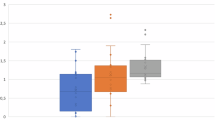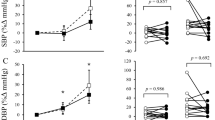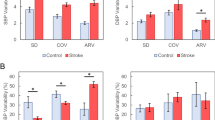Abstract
Background:
Cold application to the hand (CAH) is associated in healthy people with increase in heart rate (HR) and blood pressure (BP).
Objective:
To study hemodynamic responses to CAH in humans following spinal cord injuries of various levels, and examine the effect of spinal cord integrity on the cold pressor response.
Design:
An experimental controlled study.
Setting:
The spinal research laboratory, Loewenstein Hospital, Raanana, Israel.
Subjects:
Thirteen healthy subjects, 10 patients with traumatic T4–6 paraplegia and 11 patients with traumatic C4–7 tetraplegia.
Main outcome measures:
HR, BP, HR and BP spectral components (low frequency, LF; high frequency, HF; LF/HF), cerebral blood flow velocity (CBFV) and cerebrovascular resistance index (CVRi).
Methods:
The outcome measures of the three subject groups monitored for HR, BP and CBFV were compared from 5 min before to 5 min after 40–150 s of CAH. The recorded signals were digitized online and analyzed offline in both the time and frequency domains.
Results:
During CAH, HR and CVRi increased significantly in all subject groups (P<0.001), and BP in control subjects and in the tetraplegia group (P<0.01). BP increase was not statistically significant in paraplegia, and CBFV, HR LF, HR HF and BP LF did not change significantly during CAH in any group.
Conclusions:
The CAH effect in tetraplegia and the suppressed BP increase in paraplegia, supported by the other findings, suggest a contribution of an independent thoracic spinal mechanism to the cold pressor response.
Similar content being viewed by others
Log in or create a free account to read this content
Gain free access to this article, as well as selected content from this journal and more on nature.com
or
References
Scharf M, Korczyn AD . Cold pressor test. In: Korczyn AD (ed). Handbook of Autonomic Nervous System Dysfunction. Marcel Decker: New York, 1995, pp 557–562.
Shoemaker JK, Hogeman CS, Khan M, Kimmerly DS, Sinoway LI . Gender affects sympathetic and hemodynamic responses to postural stress. Am J Physiol Heart Circ Physiol 2001; 281: H2028–H2035.
Roatta S, Micieli G, Bosone D, Losano G, Bini R, Cavallini A et al. Effect of generalised sympathetic activation by cold pressor test on cerebral haemodynamics in healthy humans. J Auton Nerv Syst 1998; 71: 159–166.
Oblak JP, Zaletel M, Zvan B, Kiauta T, Pogacnik T . The effect of age on cerebrovascular reactivity to cold pressor test and head-up tilt. Acta Neurol Scand 2002; 106: 30–33.
Zvan B, Zaletel M, Pretnar J, Pogacnik T, Kiauta T . Influence of the cold pressor test on the middle cerebral artery circulation. J Auton Nerv Syst 1998; 74: 175–178.
Sohn YH . Cerebral hemodynamic changes induced by sympathetic stimulation tests. Yonsei Med J 1998; 39: 322–327.
Micieli G, Tassorelli C, Bosone D, Cavallini A, Viotti E, Nappi G . Intracerebral vascular changes induced by cold pressor test: a model of sympathetic activation. Neurol Res 1994; 16: 163–167.
Lehmann KG, Shandling AH, Yusi AU, Froelicher VF . Altered ventricular repolarization in central sympathetic dysfunction associated with spinal cord injury. Am J Cardio 1989; 63: 1498–1504.
Reiser MF, Ferris Jr EB . The nature of the cold pressor test and its significance in relation to neurogenic and humoral mechanisms in hypertension. Clin Invest 1948; 27: 156–163.
Maynard Jr FM, Bracken MB, Creasey G, Ditunno Jr JF, Donovan WH, Ducker TB et al. International standards for neurological and functional classification of spinal cord injury. American spinal injury association. Spinal Cord 1997; 35: 266–274.
Keselbrener L, Akselrod S . Selective discrete Fourier transform algorithm for time–frequency analysis: method and application on simulated and cardiovascular signals. IEEE Trans Biomedical Eng 1996; 43: 789–802.
DeWitt LD, Wechsler LR . Transcranial Doppler. Stroke 1988; 19: 915–922.
Akselrod S . Spectral analysis of fluctuations in heart rate and other cardiovascular parameters as a tool for assessment of autonomic control. In: Korczyn AD (ed). Handbook of Autonomic Nervous System Dysfunction. Marcel Decker: New York, 1995, pp 469–493.
Malpas SC . The rhythmicity of sympathetic nerve activity. Prog Neurobiol 1998; 56: 65–96.
Guyton AC, Hall JE (eds). Cerebral blood flow, the cerebrospinal fluid, and brain metabolism. In: Textbook of Medical Physiology. WB Saunders: Philadelphia, 1996, pp 783–789.
Catz A, Bluvshtein V, Pinhas I, Akselrod S, Gelernter I, Nissel T et al. Hemodynamic effects of liquid food ingestion in mid-thoracic paraplegia: is supine postprandial hypotension related to thoracic spinal cord damage? Spinal Cord 2007; 45: 96–103.
Acknowledgements
This study was supported by the Unit of Medical Services, Rehabilitation Department, Israel Ministry of Defense and by the Tel-Aviv University Research Fund. The Transcranial Doppler device was provided for the study by Rimed Ltd, Israel. We thank Mrs Ora Philo and the nursing team of the Spinal Rehabilitation Department in Loewenstein Hospital for their help.
Author information
Authors and Affiliations
Corresponding author
Rights and permissions
About this article
Cite this article
Catz, A., Bluvshtein, V., Pinhas, I. et al. Cold pressor test in tetraplegia and paraplegia suggests an independent role of the thoracic spinal cord in the hemodynamic responses to cold. Spinal Cord 46, 33–38 (2008). https://doi.org/10.1038/sj.sc.3102055
Received:
Revised:
Accepted:
Published:
Issue date:
DOI: https://doi.org/10.1038/sj.sc.3102055
Keywords
This article is cited by
-
A comparison of static and dynamic cerebral autoregulation during mild whole-body cold stress in individuals with and without cervical spinal cord injury: a pilot study
Spinal Cord (2018)
-
Cold pressor test in spinal cord injury—revisited
Spinal Cord (2018)
-
Cerebrovascular autoregulation: lessons learned from spaceflight research
European Journal of Applied Physiology (2013)
-
Severity of autonomic dysfunction in patients with complete spinal cord injury
Clinical Autonomic Research (2012)
-
Insulin resistance in tetraplegia but not in mid-thoracic paraplegia: is the mid-thoracic spinal cord involved in glucose regulation?
Spinal Cord (2011)



